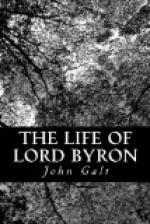The building was too vast for the establishment of Lord Byron, and he occupied only the first floor.
The life he led at this period was dull and unvaried. Billiards, conversations, reading, and occasionally writing, constituted the regular business of the day. In the cool of the afternoon, he sometimes went out in his carriage, oftener on horseback, and generally amused himself with pistol practice at a five-paul piece. He dined at half an hour after sunset, and then drove to Count Gamba’s, where he passed several hours with the Countess Guiccioli, who at that time still resided with her father. On his return he read or wrote till the night was far spent, or rather till the morning was come again, sipping at intervals spirits diluted with water, as medicine to counteract some nephritic disorder to which he considered himself liable.
Notwithstanding the tranquillity of this course of life, he was accidentally engaged in a transaction which threatened unpleasant consequences, and had a material effect on his comfort. On the 21st of March, 1822, as he was returning from his usual ride, in company with several of his friends, a hussar officer, at full speed, dashed through the party, and violently jostled one of them. Lord Byron, with his characteristic impetuosity, instantly pushed forwards, and the rest followed, and overtook the hussar. His Lordship inquired what he meant by the insult; but for answer, received the grossest abuse: on which he and one of his companions gave their cards, and passed on. The officer followed, hallooing, and threatening with his hand on his sabre. They were now near the Paggia gate. During this altercation, a common artilleryman interfered, and called out to the hussar, “Why don’t you arrest them?—command us to arrest them.” Upon which the officer gave the word to the guard at the gate. His Lordship, hearing the order, spurred his horse, and one of his party doing the same, they succeeded in forcing their way through the soldiers, while the gate was closed on the rest of the party, with whom an outrageous scuffle ensued.
Lord Byron, on reaching his palace, gave directions to inform the police, and, not seeing his companions coming up, rode back towards the gate. On his way the hussar met him, and said, “Are you satisfied?”—“No: tell me your name!”—“Serjeant-major Masi.” One of his Lordship’s servants, who at this moment joined them, seized the hussar’s horse by the bridle, but his master commanded him to let it go. The hussar then spurred his horse through the crowd, which by this time had collected in front of the Lanfranchi palace, and in the attempt was wounded by a pitchfork. Several of the servants were arrested, and imprisoned: and, during the investigation of the affair before the police, Lord Byron’s house was surrounded by the dragoons belonging to Serjeant-major Masi’s troop, who threatened to force the doors. The result upon these particulars was not just; all Lord Byron’s Italian servants were banished from Pisa; and with them the father and brother of the Guiccioli, who had no concern whatever in the affair. Lord Byron himself was also advised to quit the town, and, as the Countess accompanied her father, he soon after joined them at Leghorn, and passed six weeks at Monte Nero, a country house in the vicinity of that city.




